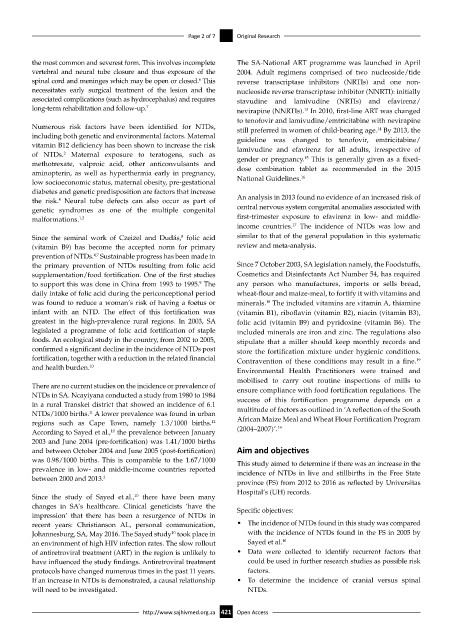Page 429 - HIVMED_v21_i1.indb
P. 429
Page 2 of 7 Original Research
the most common and severest form. This involves incomplete The SA-National ART programme was launched in April
vertebral and neural tube closure and thus exposure of the 2004. Adult regimens comprised of two nucleoside/tide
6
spinal cord and meninges which may be open or closed. This reverse transcriptase inhibitors (NRTIs) and one non-
necessitates early surgical treatment of the lesion and the nucleoside reverse transcriptase inhibitor (NNRTI): initially
associated complications (such as hydrocephalus) and requires stavudine and lamivudine (NRTIs) and efavirenz/
long-term rehabilitation and follow-up. 7 nevirapine (NNRTIs). In 2010, first-line ART was changed
13
to tenofovir and lamivudine/emtricitabine with nevirapine
Numerous risk factors have been identified for NTDs, still preferred in women of child-bearing age. By 2013, the
14
including both genetic and environmental factors. Maternal guideline was changed to tenofovir, emtricitabine/
vitamin B12 deficiency has been shown to increase the risk lamivudine and efavirenz for all adults, irrespective of
of NTDs. Maternal exposure to teratogens, such as gender or pregnancy. This is generally given as a fixed-
2
15
methotrexate, valproic acid, other anticonvulsants and dose combination tablet as recommended in the 2015
aminopterin, as well as hyperthermia early in pregnancy, 16
low socioeconomic status, maternal obesity, pre-gestational National Guidelines.
diabetes and genetic predisposition are factors that increase
the risk. Neural tube defects can also occur as part of An analysis in 2013 found no evidence of an increased risk of
4
genetic syndromes as one of the multiple congenital central nervous system congenital anomalies associated with
malformations. 1,2 first-trimester exposure to efavirenz in low- and middle-
17
income countries. The incidence of NTDs was low and
8
Since the seminal work of Czeizel and Dudás, folic acid similar to that of the general population in this systematic
(vitamin B9) has become the accepted norm for primary review and meta-analysis.
prevention of NTDs. Sustainable progress has been made in
4,7
the primary prevention of NTDs resulting from folic acid Since 7 October 2003, SA legislation namely, the Foodstuffs,
supplementation/food fortification. One of the first studies Cosmetics and Disinfectants Act Number 54, has required
9
to support this was done in China from 1993 to 1995. The any person who manufactures, imports or sells bread,
daily intake of folic acid during the periconceptional period wheat-flour and maize-meal, to fortify it with vitamins and
was found to reduce a woman’s risk of having a foetus or minerals. The included vitamins are vitamin A, thiamine
18
infant with an NTD. The effect of this fortification was (vitamin B1), riboflavin (vitamin B2), niacin (vitamin B3),
greatest in the high-prevalence rural regions. In 2003, SA folic acid (vitamin B9) and pyridoxine (vitamin B6). The
legislated a programme of folic acid fortification of staple included minerals are iron and zinc. The regulations also
foods. An ecological study in the country, from 2002 to 2005, stipulate that a miller should keep monthly records and
confirmed a significant decline in the incidence of NTDs post store the fortification mixture under hygienic conditions.
fortification, together with a reduction in the related financial Contravention of these conditions may result in a fine.
19
and health burden. 10
Environmental Health Practitioners were trained and
mobilised to carry out routine inspections of mills to
There are no current studies on the incidence or prevalence of ensure compliance with food fortification regulations. The
NTDs in SA. Ncayiyana conducted a study from 1980 to 1984
in a rural Transkei district that showed an incidence of 6.1 success of this fortification programme depends on a
multitude of factors as outlined in ‘A reflection of the South
NTDs/1000 births. A lower prevalence was found in urban
11
12
regions such as Cape Town, namely 1.3/1000 births. African Maize Meal and Wheat Flour Fortification Program
19
According to Sayed et al., the prevalence between January (2004–2007)’.
10
2003 and June 2004 (pre-fortification) was 1.41/1000 births
and between October 2004 and June 2005 (post-fortification) Aim and objectives
was 0.98/1000 births. This is comparable to the 1.67/1000 This study aimed to determine if there was an increase in the
prevalence in low- and middle-income countries reported incidence of NTDs in live and stillbirths in the Free State
between 2000 and 2013. 2
province (FS) from 2012 to 2016 as reflected by Universitas
Hospital’s (UH) records.
Since the study of Sayed et al., there have been many
10
changes in SA’s healthcare. Clinical geneticists ‘have the Specific objectives:
impression’ that there has been a resurgence of NTDs in
recent years: Christianson AL, personal communication, • The incidence of NTDs found in this study was compared
10
Johannesburg, SA, May 2016. The Sayed study took place in with the incidence of NTDs found in the FS in 2005 by
an environment of high HIV infection rates. The slow rollout Sayed et al. 10
of antiretroviral treatment (ART) in the region is unlikely to • Data were collected to identify recurrent factors that
have influenced the study findings. Antiretroviral treatment could be used in further research studies as possible risk
protocols have changed numerous times in the past 11 years. factors.
If an increase in NTDs is demonstrated, a causal relationship • To determine the incidence of cranial versus spinal
will need to be investigated. NTDs.
http://www.sajhivmed.org.za 421 Open Access

